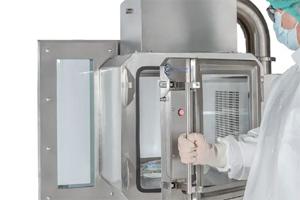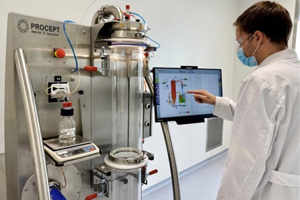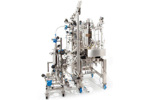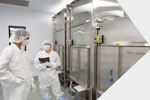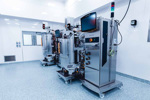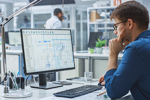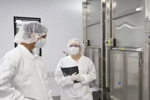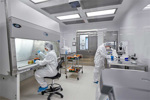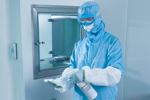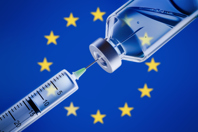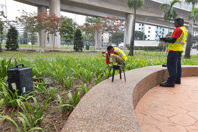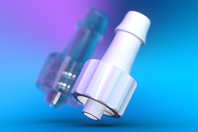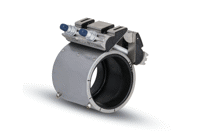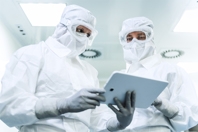Cleanroom solutions and research
CLEANROOM PRODUCTS
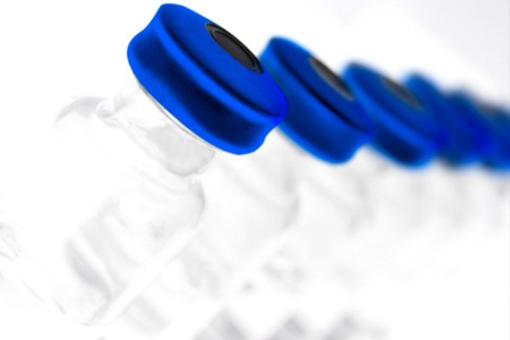 Primary Pharmaceutical Glass Packaging
Primary Pharmaceutical Glass Packaging
We’ve applied our expertise in glass science, optical physics, vapor deposition, precision forming, and extrusion to design and develop a 21st century glass container to protect 21st century drugs and vaccines. Corning® Valor® Glass vials enhance the storage and delivery of drugs, providing more reliable access to medicines essential to public health.
-
Pharmaceutical Horizontal Laminar Flow Hoods
Premium Quality, Superior Product Protection
Our Horizontal Laminar Flow Hoods are USP <797> compliant and designed for the handling of sterile products in an aseptic working environment. The work area is continuously bathed with positive pressure ISO 5/Class 100 horizontal laminar flow air that has passed through a High Efficiency Particulate Air (HEPA) filter. This filter removes organisms and particulates 0.3 micron in size with an efficiency of 99.99%. The laminar airflow principle consists of moving individual streams of unidirectional, ultra-clean air along parallel lines with minimal turbulence. The HEPA filter is positioned in the rear of the work area and is protected by a removable, perforated metal diffuser.
-
Stainless Steel Centrifuges for Regenerative Medicines
Clean-in-Place / Sterilize-in-Place System
The Powerfuge P12 System is a batch liquid/solid separation system for bacteria, yeast, proteins and sub-micron particles. It is designed to provide continuous-flow two-phase separation of solids and liquids and meets cGMP and CE requirements as well as chemical and pharmaceutical industry protocols.
- Bowl capacity: 8L
- Flow rates up to 500 L/hr for batches up to 500 L
- Footprint ~ 78.7 cm wide x 172.7 cm deep x 203.2 cm high (31” x 68” x 80”)
- Total weight ~ 1924 kg (4,240 lbs)
- Fully scalable to smaller automated Pilot and P6 models
- Fully scalable to larger automated P18 model
- Drier solids and clear liquids
-
Pharmaceutical Cleanroom Facilities For Sterile Drug Manufacturing
In the spectrum of pharmaceutical manufacturing facilities, injectable product manufacturing facilities represent the most sophisticated and challenging to design, build, qualify and operate, particularly when products manufactured in these facilities are rendered sterile when complete, ready to inject directly into a human. For this reason, very careful consideration must be made when developing such a facility.
-
Pharmaceutical Facility Monitoring System
Facility Monitoring System with industrial control systems assures data integrity, process automation, simplicity of use, and data integration.
-
Cleanrooms And Equipment For Viral Vector Drug Manufacturing
Viral vector manufacturing: key to successful gene therapy
Viral vector manufacturing, critical to the burgeoning field of gene therapy, is revolutionizing medicine with its rapid growth and significant potential for treating genetic disorders. By adhering to stringent cleanroom requirements, including BSL-2 standards, Germfree enables the safe and efficient production of viral vectors like AAV and lentivirus. Our specialized cleanroom solutions support the continued advancement of this vital therapeutic field, shaping the future of healthcare worldwide.
-
Pharmaceutical Cleanroom Design Services
Your next cleanroom is more akin to a piece of equipment than a room. Operational efficiencies, compliant flow of materials and personnel, and lifecycle considerations should dictate the selection of your cleanroom partner. AES designers have been engineering functional cleanroom facilities for over three decades, guaranteeing the performance of each and every facility. Our in-house designers work as a team with our cleanroom construction personnel to engineer a cost-effective project while maximizing performance, value, and constructability. The greatest value is realized when AES is integrated into the design team at the start of the project. Early project integration with the AES experts helps the infrastructure team decide what support and cleanroom solutions the clean space requires. Early participation by AES saves design costs, expedites schedule, and eliminates a duplication of services.
-
Rapid Design-Build Cleanroom Solutions: AES Fast-Lane Program
Speed-to-market is the number one driver in the pharma/bio industry today ... the faster our clients can build facilities, the quicker they can get treatments into the hands of the patients who need them the most. The AES Fast Lane program is an accelerated Design, Manufacture, and Installation program that fast tracks your cleanroom facility project in seven months.
-
Cleanrooms And Equipment For Monoclonal Antibodies Manufacturing
Navigating the technical challenges of mAbs production and scalability
Monoclonal antibodies (mAbs) offer promising immunotherapy treatments, targeting antigens and diseases. Manufacturing these complex therapies presents challenges in scaling up, cost, and consistency. Germfree’s expertise in tailored cleanroom solutions addresses these obstacles, ensuring sterility and seamless equipment integration. By providing advanced facilities for both small-scale clinical trials and larger-scale production, Germfree contributes to the successful development and commercialization of mAbs, ultimately improving patient outcomes and transforming healthcare landscapes.
-
Cleanrooms And Equipment For Cell Therapy Drug Manufacturing
Delivering on the promise of cell and gene therapy through Germfree products and services.
Germfree Laboratories offer advanced modular and mobile facilities, equipment, and comprehensive services for cell therapy manufacturing. Acknowledging the complexity of personalized treatments, Germfree’s adaptable solutions optimize production processes, ensuring aseptic conditions, scalability, and compliance with regulatory standards. This enables efficient, high-quality cell therapy delivery to patients in need, supporting manufacturers in overcoming industry challenges.
-
Optimize Your Contamination Control Strategy
An optimized and effective Contamination Control Strategy (CCS) helps you organization spend less time cleaning and more time manufacturing. Ecolab Life Sciences experts are dedicated to helping you drive the best possible strategy to meet and exceed the GMO Annex 1 CCS requirements.
CLEANROOM OVERVIEW
Cleanrooms can be very large. Entire manufacturing facilities can be contained within a cleanroom with factory floors covering thousands of square meters. They are used extensively in semiconductor manufacturing, biotechnology, the life sciences and other fields that are very sensitive to environmental contamination.
The air entering a cleanroom from outside is filtered to exclude dust, and the air inside is constantly recirculated through high-efficiency particulate air (HEPA) and/or ultra-low penetration air (ULPA) filters to remove internally generated contaminants.
Staff enter and leave through airlocks (sometimes including an air shower stage), and wear protective clothing such as hoods, face masks, gloves, boots and coveralls.
Equipment inside the cleanroom is designed to generate minimal air contamination. Only special mops and buckets are used. Cleanroom furniture is designed to produce a minimum of particles and to be easy to clean.
Common materials such as paper, pencils, and fabrics made from natural fibers are often excluded, and alternatives used. Cleanrooms are not sterile (i.e., free of uncontrolled microbes);[3] only airborne particles are controlled. Particle levels are usually tested using a particle counter and microorganisms detected and counted through environmental monitoring methods.[4][5]
Some cleanrooms are kept at a positive pressure so that if there are any leaks, air leaks out of the chamber instead of unfiltered air coming in.
Some cleanroom HVAC systems control the humidity to low levels, such that extra equipment ("ionizers") is necessary to prevent electrostatic discharge (ESD) problems.
Low-level cleanrooms may only require special shoes, with completely smooth soles that do not track in dust or dirt. However, for safety reasons, shoe soles must not create slipping hazards. Access to a cleanroom is usually restricted to those wearing a cleanroom suit.[6]
In cleanrooms in which the standards of air contamination are less rigorous, the entrance to the cleanroom may not have an air shower. There is an anteroom (known as a "gray room"), in which clean-room clothing must be put on, from which a person can walk directly into the room (as seen in the photograph on the right).
Some manufacturing facilities do not use fully classified cleanrooms, but use some cleanroom practices to maintain their contamination requirements.[7][8]
Air flow principles

Air flow pattern for "Laminar Flow Cleanroom"
|
Cleanrooms maintain particulate-free air through the use of either HEPA or ULPA filters employing laminar or turbulent air flow principles. Laminar, or unidirectional, air flow systems direct filtered air downward in a constant stream towards filters located on walls near the cleanroom floor or through raised perforated floor panels to be recirculated. Laminar air flow systems are typically employed across 80 percent of a cleanroom ceiling to maintain constant air processing. Stainless steel or other non-shed materials are used to construct laminar air flow filters and hoods to prevent excess particles entering the air. Turbulent, or non-unidirectional, air flow uses both laminar air flow hoods and non-specific velocity filters to keep air in a cleanroom in constant motion, although not all in the same direction. The rough air seeks to trap particles that may be in the air and drive them towards the floor, where they enter filters and leave the cleanroom environment.[9]
Cleanroom classifications
Cleanrooms are classified according to the number and size of particles permitted per volume of air. Large numbers like "class 100" or "class 1000" refer to FED-STD-209E, and denote the number of particles of size 0.5 µm or larger permitted per cubic foot of air. The standard also allows interpolation, so it is possible to describe, for example, "class 2000".
A discrete-particle-counting, light-scattering instrument is used to determine the concentration of airborne particles, equal to and larger than the specified sizes, at designated sampling locations.
Small numbers refer to ISO 14644-1 standards, which specify the decimal logarithm of the number of particles 0.1 µm or larger permitted per cubic metre of air. So, for example, an ISO class 5 cleanroom has at most 105 = 100,000 particles per cubic metre.
Both FS 209E and ISO 14644-1 assume log-log relationships between particle size and particle concentration. For that reason, zero particle concentration does not exist. The table locations without entries are non-applicable combinations of particle sizes and cleanliness classes, and should not be read as zero.
Because 1 m3 is approximately 35 ft3, the two standards are mostly equivalent when measuring 0.5 µm particles, although the testing standards differ. Ordinary room air is approximately class 1,000,000 or ISO 9.[10]
US FED STD 209E cleanroom standards
| Class | maximum particles/ft3 |
ISO equivalent |
||||
|---|---|---|---|---|---|---|
| ≥0.1 µm | ≥0.2 µm | ≥0.3 µm | ≥0.5 µm | ≥5 µm | ||
| 1 | 35 | 7.5 | 3 | 1 | 0.007 | ISO 3 |
| 10 | 350 | 75 | 30 | 10 | 0.07 | ISO 4 |
| 100 | 3,500 | 750 | 300 | 100 | 0.7 | ISO 5 |
| 1,000 | 35,000 | 7,500 | 3000 | 1,000 | 7 | ISO 6 |
| 10,000 | 350,000 | 75,000 | 30,000 | 10,000 | 70 | ISO 7 |
| 100,000 | 3.5×106 | 750,000 | 300,000 | 100,000 | 700 | ISO 8 |
US FED STD 209E was officially cancelled by the General Services Administration of the US Department of Commerce November 29, 2001,[11][12] but is still widely used.
ISO 14644-1 cleanroom standards
| Class | maximum particles/m3 |
FED STD 209E equivalent |
|||||
|---|---|---|---|---|---|---|---|
| ≥0.1 µm | ≥0.2 µm | ≥0.3 µm | ≥0.5 µm | ≥1 µm | ≥5 µm | ||
| ISO 1 | 10 | 2.37 | 1.02 | 0.35 | 0.083 | 0.0029 | |
| ISO 2 | 100 | 23.7 | 10.2 | 3.5 | 0.83 | 0.029 | |
| ISO 3 | 1,000 | 237 | 102 | 35 | 8.3 | 0.29 | Class 1 |
| ISO 4 | 10,000 | 2,370 | 1,020 | 352 | 83 | 2.9 | Class 10 |
| ISO 5 | 100,000 | 23,700 | 10,200 | 3,520 | 832 | 29 | Class 100 |
| ISO 6 | 1.0×106 | 237,000 | 102,000 | 35,200 | 8,320 | 293 | Class 1,000 |
| ISO 7 | 1.0×107 | 2.37×106 | 1,020,000 | 352,000 | 83,200 | 2,930 | Class 10,000 |
| ISO 8 | 1.0×108 | 2.37×107 | 1.02×107 | 3,520,000 | 832,000 | 29,300 | Class 100,000 |
| ISO 9 | 1.0×109 | 2.37×108 | 1.02×108 | 35,200,000 | 8,320,000 | 293,000 | Room air |
BS 5295 cleanroom standards
| maximum particles/m3 | ||||||
| Class | ≥0.5 µm | ≥1 µm | ≥5 µm | ≥10 µm | ≥25 µm | |
|---|---|---|---|---|---|---|
| Class 1 | 3,000 | 0 | 0 | 0 | ||
| Class 2 | 300,000 | 2,000 | 30 | |||
| Class 3 | 1,000,000 | 20,000 | 4,000 | 300 | ||
| Class 4 | 200,000 | 40,000 | 4,000 | |||
BS 5295 Class 1 also requires that the greatest particle present in any sample does not exceed 5 μm.[13]
GMP EU classification
| Class | maximum particles/m3[14] | |||
|---|---|---|---|---|
| At Rest | At Rest | In Operation | In Operation | |
| 0.5 µm | 5 µm | 0.5 µm | 5 µm | |
| Class A | 3,520 | 20 | 3,520 | 20 |
| Class B | 3,520 | 29 | 352,000 | 2,900 |
| Class C | 352,000 | 2,900 | 3,520,000 | 29,000 |
| Class D | 3,520,000 | 29,000 | n/a | n/a |
CLEANROOM WHITEPAPERS AND CASE STUDIES
-
As timelines tighten and regulatory demands grow, discover how a European CDMO delivers integrated solutions from aseptic fill and finish to packaging and release.
-
Druck’s Customer is a manufacturer of data logging equipment, used in the monitoring of water distribution systems. As with many of Druck’s Customers, they install sensors into the component or assembly that they in turn supply to their customer.
-
A custom hexapod was introduced at ILA Berlin 2024, enhancing precision in aircraft construction. This 6-DOF system improves contour machining of CFRP components, reducing manufacturing times and costs.
-
Read about a non-invasive and non-intrusive technology that enables rapid inspection of large areas of a water distribution network without removing the pipelines from service, avoiding service interruptions, pipeline dewatering/cleaning, or costly excavations.
-
The use of single-use plastic luer fittings in medical settings, medical devices, and patient care is an example where the sustainability versus safety debate arises. This white paper aims to explore this debate and offer insights into the challenges and opportunities that lie ahead.
-
Discover how science-based bio-decontamination strategies effectively eliminate invisible pathogens and rapidly restore facilities to operational safety following major infrastructure disruptions.
-
Read about a utility that was looking for a quick, cost-effective yet resilient solution that would prevent the disruption of water service to the community and environment.
-
Explore the development of a mobile Biosafety Level 2+ (BSL-2+) facility adhering to cGMP for early-phase clinical trial manufacturing.
-
An essential part of AAV vector production is the characterization of potential CQAs. Learn about novel, robust, and orthogonal methods that can be used to assess identity, purity, and residuals.
-
Environmental monitoring in cleanrooms should be performed using suitable techniques that meet the needs of the risk assessment. Learn about the requirements, typical instrumentation features, and more.
-
The biopharmaceutical industry is increasingly employing micro-flow imaging for particle characterization, owing to the superior insights it can afford into product quality and process controls.
-
Airflow visualization studies, crucial for GMP compliance, validate unidirectional airflow effectiveness in contamination control. Discover their enhanced role in quality by design and revised Annex 1 guidelines.
-
Filtration removes contaminants to ensure safety and is essential in various applications, from lab-scale tasks to GMP production. Explore how its simplicity and reliability make it indispensable.
-
See how one manufacturer expanded its production capacity with a modular BSL-2LS cGMP facility built to meet evolving CDMO needs while ensuring robust engineering controls and flexible design.


